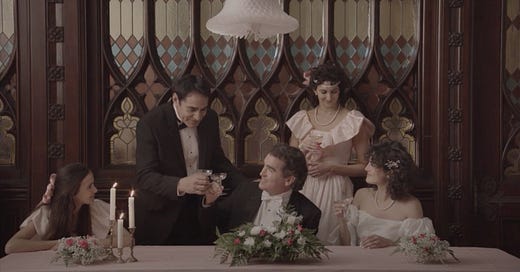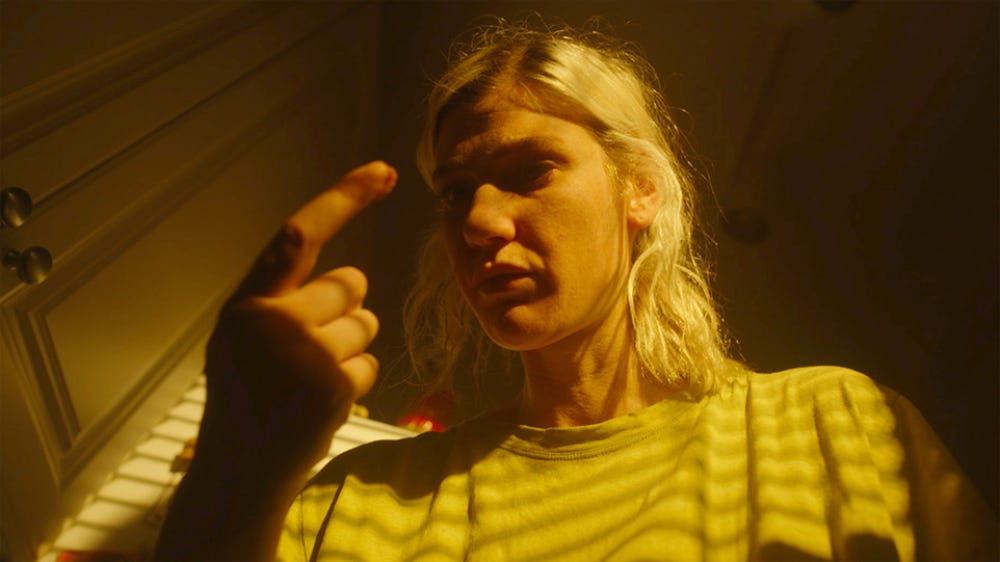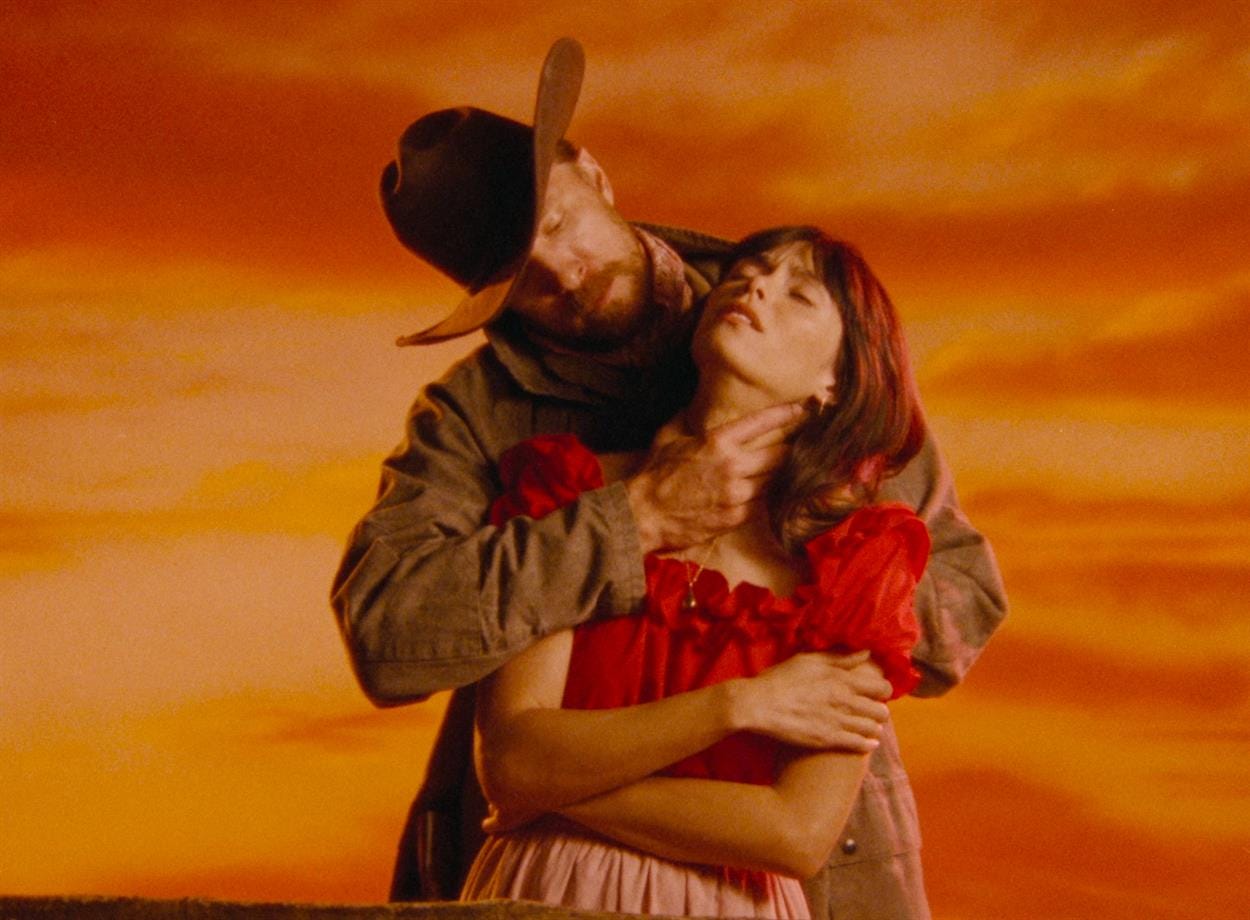Chances Are That Costume Came From Nell Simon
The costume designer behind films like 'Good One,' 'The Cathedral,' and 'Inspector Ike' discusses her process, her approach to color, and collaborating with different directors.
Hello! Welcome to Nothing Bogus, an Indie Film Listings+ newsletter. The + is commentary, interviews, dispatches, tutorials, and other groovy stuff. I’m going to start with the +. If you subscribed for the listings and only the listings, scroll as fast as you can to the bottom of this email. If you came for the +, no scrolling necessary :)
If there’s one through-line connecting the current wave of low budget Brooklyn indies, it’s arguably the costumes. Though you wouldn’t know it. The dads of Dad & Step-Dad don’t exactly look like they shop at the same stores as the thespians in Inspector Ike — or even the dads of Good One. But all of these films — as well as Ricky D’Ambrose’s The Cathedral, Joanna Arnow’s The Feeling That the Time for Doing Something Has Passed, Mary Dauterman’s upcoming Booger, and Rachel Wolther’s upcoming The French Italian — share the same costume designer: Nell Simon.
After seeing Simon’s name pop up in the credits of so many cool films I’d been seeing — she also worked on the shorts Gold & Mud and We Should Get Dinner! — I wanted to learn more about her process and approach. We discussed the best local thrift shops, quick fixes for stains, and how directors can most effectively communicate with her department.
What's your background? How did you get into doing costume and wardrobe?
Well, I went to Barnard College, and I studied Theater there. I was on the theater department email list when I was a student and this designer named Liz Vastola was looking for interns for this scripted narrative MTV show she was designing, and I did that during my junior year. At that point, I was just organizing returns and helping with paperwork one day a week, but I loved it. It opened my eyes to the fact that people could do this for a living. I had never been exposed to the film and TV side of costumes. I only was familiar with theater costumes. And later that summer, Liz and I would regularly get coffee and she would essentially give me lessons about costume design — how to do research, how to use SyncOnSet, which was the continuity software that every movie and TV show used, etc.
Do you remember what specifically you were learning?
I was learning pretty much everything that goes into creating the visual world of a movie, how to communicate that to a director, and how to run your department. At the time, Liz was prepping for the third Purge movie, so she was going through all these books for research. It's really widespread. It takes weeks and months to prep for this. And I was learning where she draws research from.
While Liz was teaching me things, she also introduced me to her friend Stacey Berman, who I interned for the next year and continued to work with for a long time. I assisted Stacey and Karen Boyer on a movie called Chained For Life, directed by Aaron Schimberg, and that was a pivotal experience for me. It's such an unusual movie, so it opened my eyes to how unconventional you could be — like, nothing is telling us not to do this.
What is the research process like?
I'll usually read the script once without making too many notes, and I’ll jot down first impressions that come to me of what this world could feel like visually. Then I’ll read it again and make notes and then a costume breakdown. And then I'll start doing visual research for costume boards — it’s really great to do it with physical books. But usually I'll end up on the internet. My goal the majority of the time is to find images of actual people — not branded content-type images or anything editorial. Of course, this depends on the project, but that’s my usual aim when creating boards.
For example, for the board I created for Sam (Lily Collias) from Good One, I have a picture of my cousin and her friend that’s reminiscent of scenes between Sam and her best friend. I have a picture from Flickr of a woman hiking. I have some photos from Pinterest and some from Instagram. I might have a few from random hiking companies’ websites, but ones that happen to look better than the average branded content.
Are you taking things in with an open mind or looking for something specific?
It depends on the project. These boards take a lot of editing and going through multiples versions. Sometimes I will have something very specific in mind, but that's hard because that doesn't always exist in the world. So then you try to find images that communicate the feel of whatever that is to the director. The goal is, by the end of the process, to both picture the same thing for these characters, agree that this is right for the feel of your film, and that these will guide you to be able to accomplish that.
Do you have philosophies around color?
Usually it does end up there. By the time the final costume choices are made, there is some deeper meaning to the colors picked. In Good One, we wanted the two men to have more of a cool toned palette and Lily [Collias] to have more of a warm colored palette. We talked about whether we wanted the colors to blend in with the natural world or stand out.
Another example is in Mary Dauterman’s upcoming film, Booger. Eventually we end up with booger-y bright greens by the end. Mary had this great idea to make something called a “color document,” where it was a collaboration between her, my department, and the art department. We documented the main character Anna's color progression, where it starts off warm and eventually gets to these gross colors. There are production design elements to it too. This document had photos of locations, the key props, and her fitting photos, so we're able to track this progression that's in line with the character's journey. It was my job to help figure out how to do that with costumes while still making it look like something that this character already owned or would wear.
You've got to thread that needle of what that character would wear and also the bigger idea behind the colors' meanings and where a character is at at a given moment. So how are you doing that?
The visual research stage is when I’ll be figuring out what sorts of stuff this person wears, and this is through conversation with the director. And it is nice to talk to the actor, not only because they are literally physically embodying the character, but also because they may have their own worthwhile thoughts while crafting this character's sensibility.
And then I'll do the sourcing. In a perfect world, I would probably thrift everything — though, it's hard because I tend to work on lower budget movies. You want to be able to go buy everything at a thrift store to make it look real. But you can't do that because you can't return things to thrift stores, and you don't know that everything will work and then you've wasted your budget at thrift stores. So you have to buy things from retail stores you can return things to so you have the freedom at your fitting to try a bunch of options.
So we have a fitting and try on a bunch of ideas. And while I'm buying these things that can be returned, I keep the color in mind and stay true to the costume boards, but there's still a lot of options. And at the fitting I always ask the actor to take a look at the rack and see if anything stands out to them — or if there's anything they would never feel comfortable wearing. And then, we just try things on. Which is so important, because it's obviously going to look so different on a person — and a person will react certain ways to certain pieces. There are these moments when you know that something the actor tried on is very special. For Grace Rex's short Shadow Wrangler, there's this red dress that the main character wears that's super similar to this $400 dress that I desperately wanted for this character. And it just worked so well, and we knew. Grace wrote it with this image in mind, of like a 1940s cowboy romance novel cover. But it had to be a bright red or orange or yellow, and it had to be something we could get multiples of, so it couldn't be real vintage.
What are the most helpful ways a director can communicate with you?
The most important thing director-communication-wise for me is that we have a shared understanding of the story the visuals will tell the audience. For example, we just did the final pickup day of Caroline Golum's movie, which is set in medieval times, and she was very clear that the vibe of this film was to be influenced by medieval art, and she had clear visual references. She was able to communicate which colors she wanted to see a lot of. And she had a few key words she'd use. She also had a lot of physical books with sticky notes attached to the key images she liked. Those were really good starting points for me. I then also looked through a lot of physical books for more costume references. But they all shared similar colors. It was all art from Europe around 1300, 1400. I made a lot of the costumes. The whole time she was very clear about what she wanted the audience to see when they look at this movie.
Do you have favorite thrift stores?
The Bushwick Urban Jungle L Train Vintage. A lot of the Inspector Ike stuff came from there. Beacon's Closet in Greenpoint and in Bushwick, I'll go to both of them a lot. I don't think I have any secret ones. For Dad & Step-Dad, I happened to be working on something else in New Jersey, so I went to New Jersey thrift stores, and that was good for Branson's costume. As was Burlington Coat Factory. So if you want to dress like Branson...
Do you feel like you have a personal sensibility? Or something that separates you from other people who do costumes?
I like to find the line where clothes can become just a little funny. Like in The French Italian, most of it isn’t meant to be overtly funny but it is meant to be funny. I'm also into where we can find '70s influences. I really like how people wore their pants then, for men and women. I like the shape of ties for men. And the tie and the pants are things that you can incorporate into how you wear your clothes now, just a little nod to the era.
Do you have any tricks for making practical fixes on set?
Wet ones are really good for getting out little stains.
Is there anything else you want to add before I let you go?
Something I've been thinking about is: A couple weekends ago I saw A Girl Walks Home at Night, and there was a Q&A afterwards with the director Ana Lily Amirpour and she was basically like "I don't know why more movies aren't weirder, because why not?" And I thought it was such a good thought. I’ve been thinking about that thought a lot.
Listings
Melina Valdez is available for graphic design / illustration / pitch deck work. Here is a link to Melina’s portfolio.
There are a few different casting notices out for a new Savanah Leaf short film called BIRTH. Find them here.
Juan Pablo Rivera Garza’s new short film, The Daughter, is in search of an 18-22 year old woman for an undisclosed role. The film will be shot in Vermont and New York City in late July and early August. Apply here.
If you would like to list in a future issue, either A) post in the Nothing Bogus chat thread, or B) email nothingbogus1@gmail.com with the subject “Listing.” (It’s FREE!) Include your email and all relevant details (price, dates, etc.).









